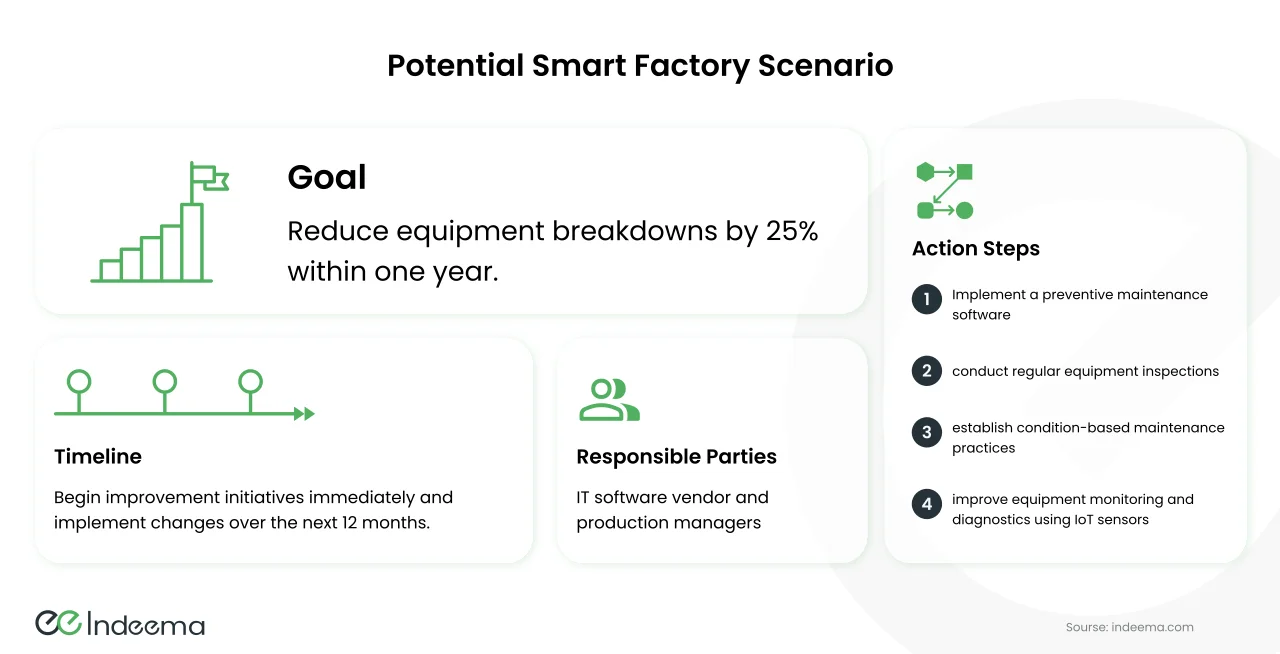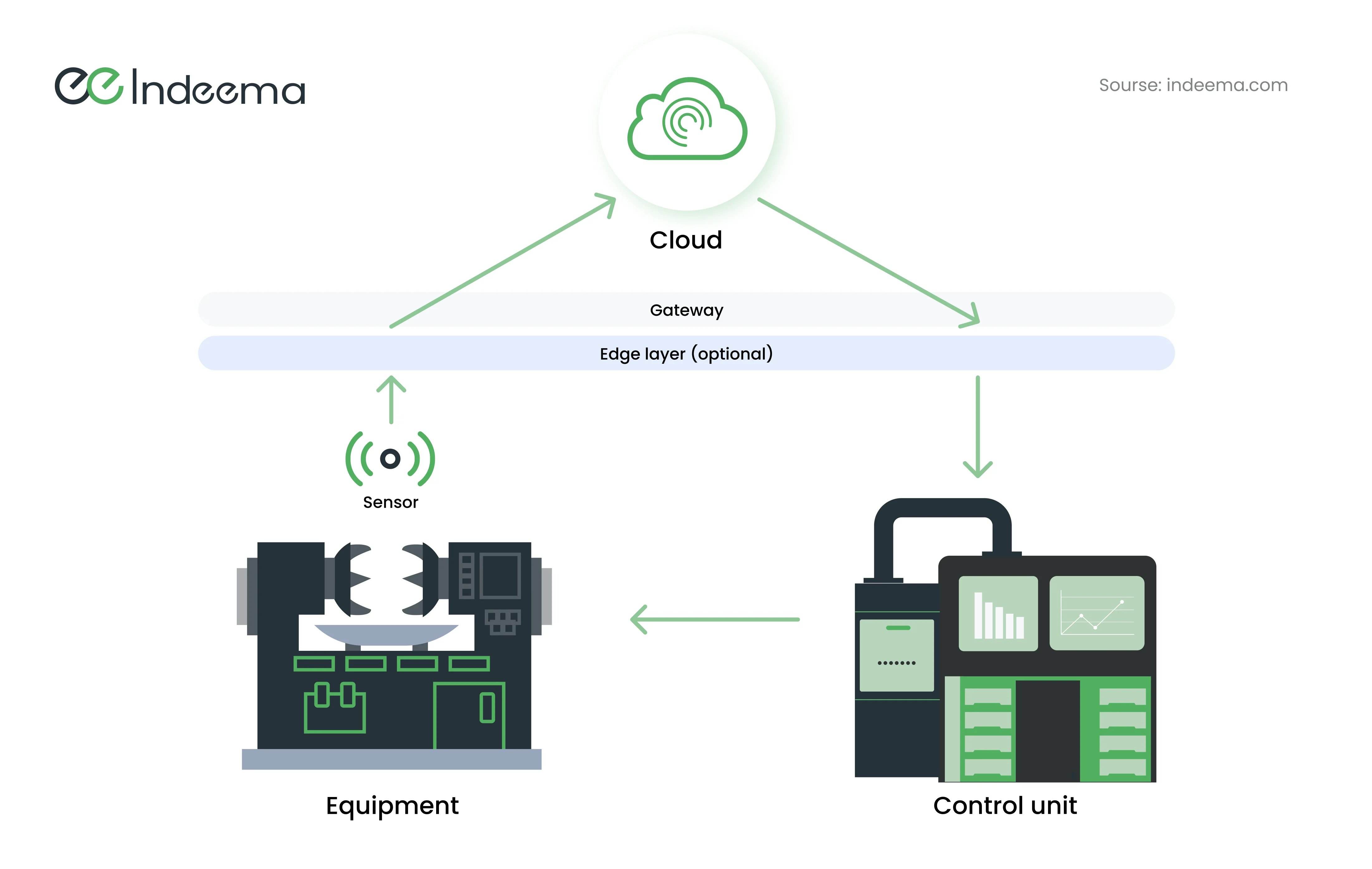Introduction
The transition to smart manufacturing, or the digital transformation of factories, entails many changes that can be difficult to comprehend as well as implement. In addition, there are usually major cost considerations associated with such improvements.
However, more and more factories are opening up to the Internet of Things and other forms of innovative engineering technology. In fact, by 2030, it is expected that the Internet of Things market in Manufacturing will be worth a mind-boggling USD 1.5 trillion.
The time for transformation is now. So, let's delve deeply into Smart Manufacturing and how to put it into action.
1. What is Smart Manufacturing?
Smart manufacturing is like having a super-smart robot assistant who knows all the tricks to make the manufacturing process run like a well-oiled machine.
The smart manufacturing definition is used to describe the implementation of cutting-edge tools and big data in the manufacturing sector. The main goal is to enhance productivity and facilitate rational decision-making.
The goal is to create a smart and interconnected production environment through the use of tools such as the Internet of Things (IoT), artificial intelligence (AI), automation, and data analytics. In practice, smart manufacturing can open up a world of possibilities. From real-time monitoring to predictive maintenance, this strategy offers a variety of competitive advantages that may help optimize operations and achieve greater success.

2. Assessing Readiness for Smart Manufacturing
Before starting down the path of implementing smart manufacturing strategy, it is important to see how ready the organization is. This means looking at the current manufacturing processes and operational technology infrastructure, as well as figuring out what the possible benefits and problems might be.
2.1 Evaluating Current Manufacturing Processes and Technologies
This task involves conducting a thorough analysis and comparison of the latest manufacturing processes and technologies with the industry's best practices, standards, and competitors. It is advisable to seek out examples of effective practices and use them as a model for your own initiatives.
As an illustration of how to set priorities, consider the following scenario.



In order to achieve the goal of reducing equipment breakdowns by 25% within one year, the responsible parties, including the IT software vendor and production managers, will take several action steps.
These steps include implementing preventive maintenance software, conducting regular equipment inspections, adopting condition-based maintenance practices, and enhancing equipment monitoring and diagnostics through the utilization of IoT sensors.
These measures aim to optimize manufacturing processes and technologies and improve overall equipment reliability.
2.2 Identifying Potential Benefits and Challenges
Both the opportunities and threats associated with adopting a smart manufacturing approach must be considered. By taking this preventative measure, businesses can prepare for and deal with any potential obstacles to a smooth rollout. Let's take a closer look at the potential upsides and downsides:
Possible Advantages:
⚈ Greater Operational Efficacy. Smart manufacturing allows for the constant monitoring of data, and the automation of tasks, all of which contribute to greater operational efficiency and productivity.
⚈ Minimized Production Downtime. Potential failures can be identified and prevented with the help of real-time monitoring of equipment and predictive maintenance.
⚈ Better quality standards and more satisfied clients. These are the results of smart manufacturing's data-driven insights and quality control measures.
⚈ Real-time data analysis and predictive modeling. Allow for more efficient utilization of available resources, with less waste.
⚈The adoption of smart manufacturing technologies might require substantial investments in infrastructure, equipment upgrades, and training programs, all of which come with their own set of challenges.
Possible Challenges:
⚈ Cybersecurity Threats. Modern digital manufacturing processes are vulnerable to cyberattacks because of the proliferation of interconnected systems and the free flow of information. Protecting critical infrastructure and sensitive data requires implementing stringent cybersecurity measures.
⚈ Employees who are unfamiliar with the new technology or who are resistant to change may push back against its implementation. Effective strategies for managing change, channels of communication, and training programs are required to meet this challenge head-on.
⚈ Identifying these and other opportunities and threats allows businesses to create customized plans to reap the most benefits and mitigate the most risk.
3. Technology Infrastructure Requirements
Implementing smart manufacturing requires a robust technology infrastructure. Assessing the current IT infrastructure, identifying required hardware and software components, and evaluating connectivity and data exchange capabilities are crucial factors to consider.
3.1 Evaluating Existing IT Infrastructure
An essential step toward the benefits of smart factory implementation of smart manufacturing is an evaluation of the current IT infrastructure, which includes servers, workstations, industrial control systems, and devices utilized in the advanced manufacturing setting. Age, performance, capacity, and compatibility with innovative technologies are just a few examples of considerations that should be made.
The evaluation may show, for example, that the manufacturing's current servers are out-of-date and unable to handle the growing amount of data being produced by IoT sensors. To facilitate the implementation of smart factory solution, it would be imperative to upgrade the servers to models that are more robust and scalable.
It would also be beneficial to evaluate the scalability and future readiness of the IT infrastructure in order to handle projected growth, emerging technologies, and evolving business requirements. For future manufacturing needs, it might be necessary to upgrade the network bandwidth, add more storage space, or use cloud-based solutions.
3.2 Identifying Necessary Hardware and Software Components
Manufacturers can confidently begin their smart manufacturing journey once the right hardware and software have been determined. These parts are the building blocks that allow for manufacturing facilities to connect, gather data and analyze it, automate processes, and optimize performance. Typical hardware and software components used in smart manufacturing are discussed below, along with some important factors to keep in mind.

Hardware Part
IoT sensors help collect real-time data from smart machines, equipment, and production processes. These sensors can measure temperature, pressure, humidity, vibration, and energy consumption, and more. In smart manufacturing, temperature sensors on machinery monitor thermal conditions to optimize performance and prevent overheating.
Robotics and automation improve manufacturing production efficiency and productivity. Industrial robots automate repetitive tasks, handle complex assembly processes, and improve production process speed and accuracy.
For example, collaborative robots (cobots) can work with humans to do tasks that require precision and strength, freeing up people to do more complicated or valuable work.
Edge computing devices are located near data sources. These devices process and analyze data locally, allowing real-time decision-making without cloud infrastructure. Edge servers in smart factories can analyze sensor data in real-time to adjust machine settings for optimal production.
Learn more about how the Indeema team engineered the hardware component for the Industrial IoT Solution, specifically designed for Vibration Diagnostics.
Software Part
Smart manufacturing equipment collects massive amounts of data, which data analytics platforms must analyze. These insights can be used to improve quality control, maintenance prediction, production schedule optimization, and operational efficiency for manufacturers.
Cloud computing and storage solutions provide scalable and secure data storage, processing, and interaction for smart factory implementation. The manufacturing sector can use the cloud to store and analyze historical data, enable remote monitoring and management, and implement predictive maintenance and quality control machine learning algorithms.
Connectivity and integration tools are needed to ensure smooth communication and data exchange between components and systems. These tools allow hardware devices, software applications, and data centers to be integrated into a single ecosystem. Industrial communication protocols, middleware, and APIs that enable system interoperability include MQTT, and others.
4. Selecting the Right Technologies and Solutions
When thinking of innovative technologies that contribute to smart manufacturing, the Internet of Things (IoT) is the first that comes to mind. This is to be expected, as the Internet of Things includes many different types of connected electronics, machinery, and industrial sensors.
However, it is equally crucial to delve deeper into the significant impact of data analytics, AI, automation, robotics, and cloud computing have had on the manufacturing process. The manufacturing industry has been completely transformed by these game-changing technologies, and here is why.
4.1 Internet of Things (IoT) and Sensor Technologies
The Internet of Things (IoT) and sensor technologies are key enablers of smart production, providing real-time data collection, monitoring, and control capabilities.
Industrial Internet of Things (IoT) sensors can improve security and safety in factories. For instance, sensors can monitor environmental conditions, detect hazardous gases or chemical leaks, and alert personnel in case of emergencies.
In the manufacturing process, IoT sensors can be used to keep an eye on the final product's quality. For example, sensors embedded in production lines can measure dimensions, detect defects, or perform quality checks at various stages. This real-time quality monitoring enables early detection of issues, reducing scrap rates, and ensuring consistent product quality. In our previous article, we delved deeper into the ways IoT facilitates intelligent industrial operations.
4.2 Data Analytics and Artificial Intelligence (AI)
Artificial intelligence algorithms can process and analyze data from sensors and energy meters to recommend energy-saving measures and pinpoint hotspots of excessive energy consumption. In this way, factories can lessen their financial and ecological footprints by enacting strategic energy efficiency initiatives.
Manufacturers can enable fully automated decision-making and response systems by combining data analytics and AI in real-time. AI algorithms can automatically optimize process parameters, machine performance settings, and production schedules based on data collected from sensors.
4.3 Automation and Robotics
With the help of industrial robots, assembly processes can be automated to boost throughput and accuracy. Assembling components, screwing them in, and soldering them are all examples of repetitive tasks that can be performed by robots, freeing up human workers to focus on more intricate or high-value tasks.
Manufacturing facilities can benefit from the use of automated guided vehicles (AGVs) or robotic arms for efficient and hands-free material handling. Raw materials, WIP parts, and finished goods can all be moved by these robots between workstations and warehouses.
Pick-and-place tasks can be accomplished rapidly and precisely by robots with vision systems and gripping mechanisms. They are able to sort, package, or palletize items efficiently because of their ability to recognize and handle items of varying shapes and sizes.
Integrating multiple robots, sensors, and automation components into a unified system creates smart robotic cells. These cells can coordinate their efforts, sharing data and completing complex projects as a team. One robot might handle the welding, another the screws, and a vision system would make sure everything was lined up right.
4.4 Cloud Computing and Edge Computing
As data is stored in the cloud, manufacturers can access it from anywhere. It helps workers from different locations work together and share data for better business decisions.
Cloud computing provides scalable infrastructure for smart manufacturing systems. In order to deal with larger data volumes, support more devices, or meet fluctuating seasonal production demands, manufacturers can increase or decrease their computing resources as needed. Because of this scalability, the infrastructure can meet evolving needs without requiring investments in hardware.

Thanks to cloud computing, data from different sources can be easily combined and shared among applications and devices. Enterprise resource planning (ERP) systems, manufacturing execution systems (MES), and Internet of Things (IoT) sensors can all share data through a centralized cloud for manufacturers. Manufacturers can now see the big picture, streamline operations, and make data-informed decisions thanks to this integration.
Conclusion
Making the transition to digital is challenging for most industries, and manufacturing is no exception. However, it's not all bad news; smart manufacturing technology can yield significant improvements in productivity and revenue in the long run, and more importantly, it can boost the business's competitiveness.
As was discussed in the article, before searching for an IoT vendor for transformation, it is important to evaluate all potential risks and the current level of production capability. Another factor in staying ahead of the competition is staying abreast of the latest production technologies. Among these are the Internet of Things, big data, artificial intelligence, automation, robotics, and cloud computing.


